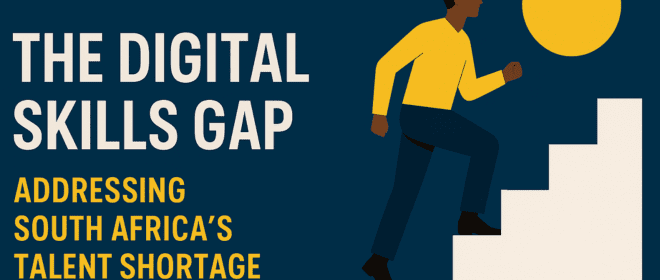The digital skills gap is no longer a looming threat—it is an urgent crisis. As artificial intelligence (AI) accelerates workplace transformation, millions risk being left behind without the necessary skills to compete in the digital economy. The World Economic Forum (WEF) warns that 23% of global jobs will change by 2027 due to AI, while South Africa faces a critical skills shortage that could derail business transformation by 2030 .
This gap isn’t just a workforce issue—it’s an economic, social, and geopolitical challenge. Without decisive action, businesses will struggle with productivity losses, nations will lag in innovation, and inequality will deepen as a result of neglecting to act fast!
The question is how do key-role players contribute to plug the gap for the digital skills shortage in South Africa?
This blog underlines:
- The role of governments in policy-making, funding, and education reform.
- The private sector’s responsibility in upskilling, partnerships, and innovation.
- How small businesses can adapt despite resource constraints.
- Tangible sovereign solutions between 2025-2030 to fast-track digital readiness.
-
Government’s Role: Policy, Investment, and Systemic Change
Governments must act as enablers, creating frameworks that incentivize digital literacy and workforce adaptability.
-
National Upskilling Initiatives
– Singapore’s SkillsFuture provides citizens with SGD 500 credits for lifelong learning, focusing on AI and data analytics .
– India’s Skill India Digital offers verified digital credentials and job-matching platforms to scale training .
– The EU’s Digital Decade targets 80% digital literacy by 2030, integrating coding and AI into school curricula .
-
Public-Private Partnerships (PPPs)
– South Africa’s Yes4Youth partners with corporations to fund digital apprenticeships .
– The U.S. CHIPS Act allocates $65 billion for broadband expansion, ensuring rural and low-income communities gain access .
-
Education Reform
– Mandating STEM and AI education in schools (e.g., Kenya’s coding curriculum).
– Subsidizing online learning (e.g., South Korea’s KoDi program, which exports digital training models globally) .
Interim Solution (2025-2030):
– Micro-credentialing: Governments can fund short, accredited courses in AI fluency, cloud computing, and cybersecurity.
– Tax incentives for businesses that train employees in digital skills.
-
Private Sector’s Responsibility: Upskilling, Innovation, and Inclusive Hiring
Corporations drive economic growth—they must lead in reskilling efforts.
-
Corporate Upskilling Programs
– Amazon’s “Upskilling 2025” trained 70,000 employees in software development, reducing staff turnover.
– Microsoft’s Global Skills Initiative offers free AI and cloud certifications to 25 million people.
-
Tech-Driven Apprenticeships
– Google’s Career Certificates bypass traditional degrees, offering direct pathways into tech roles.
– IBM’s “New Collar” jobs focus on skills over credentials, hiring based on competency-based assessments.
-
AI and Automation Integration
– AI-augmented training: Companies like PwC use VR and AI simulations to upskill employees in real-time .
– Internal gig economies: Firms like Unilever deploy AI to match employees with short-term projects that build new skills .
Interim Solution (2025-2030):
– “Skills as a Benefit” – Companies bundle digital training with employment (e.g., LinkedIn Learning subscriptions).
– Open-source learning platforms (e.g., Meta’s AI education partnerships in Africa) .
-
Small Businesses: Leveraging Agility and Community Networks
SMEs lack corporate budgets but can adopt cost-effective strategies.
-
Localized Training Hubs
– FutureDotNow (UK) provides free digital skills assessments for SMEs, helping them identify gap .
– Wix’s Latino Web Project trained students to build websites for Hispanic-owned businesses, boosting digital presence.
-
Collaborative Learning Models
– Peer-to-peer upskilling: Small businesses pool resources for group training (e.g., Shopify’s e-commerce workshops).
– Government grants: South Africa’s SMME Digital Fund subsidizes tech adoption for small enterprises .
-
AI Tools for Efficiency
– Automating repetitive tasks with AI (e.g., chatbots, QuickBooks AI for accounting).
– Cloud-based upskilling: Platforms like Coursera offer SME discounts for team training .
Interim Solution (2025-2030):
– “Digital Skills Cooperatives” – Small businesses jointly hire trainers for affordable upskilling.
– AI mentorship programs – Retired tech professionals volunteer to guide SMEs via virtual mentorship.
-
Sovereign Solutions: Bridging the Gap by 2030
-
National Digital Apprenticeship Corps
– Model: A government-backed program where tech firms host apprentices in exchange for tax breaks.
– Example: The UK’s Digital Skills Bootcamps place workers in tech roles within 16 weeks .
-
Mobile Digital Literacy Units
– Deploying vans with Wi-Fi and trainers to rural areas (inspired by India’s Digital Rath initiative).
– Partnerships with telecoms (e.g., MTN and Vodacom in Africa offering free data for e-learning) .
-
AI-Powered Job Matching Platforms
– South Africa’s GigVillage connects freelancers with digital micro-tasks to build experience and the future of work 2030.
– Singapore’s MySkillsFuture uses AI to recommend courses based on labor market trends .
-
Cybersecurity Reskilling Funds
– National cyber hubs train workers in threat analysis, funded by public-private coalitions.
– Example: Kenya’s Cyber Shujaa program reskills youth in cybersecurity for outsourced contracts .
Conclusion: A Unified Call to Action
The digital skills gap is a $11.5 trillion economic risk by 2030 if unaddressed. Have you conducted a business audit yet to figure out how you would incorporate Artificial Intelligence in business?
To bridge it, we need:
- Governments to legislate, fund, and reform education.
- Corporations to invest in scalable upskilling.
- SMEs to adopt collaborative, low-cost upskilling models.
Between 2025-2030, sovereign solutions must prioritize:
– Micro-credentials over degrees to speed up skilling.
– AI-driven personalized learning to maximize efficiency.
– Grassroots digital literacy to leave no one behind.
The time for incremental change is over. The AI era demands a reskilling revolution—and every sector must play its part. So, have you included corporate digital training programs yet into your operations? It might be more urgent than ever to do so.
References & Further Reading:
- [APMG: What is the Digital Skills Gap?](https://apmg-international.com/article/what-digital-skills-gap)
- [BizCommunity: SA’s Skills Crisis](https://www.bizcommunity.com/article/the-role-of-education-in-closing-south-africas-digital-skills-gap-694601a)
- [Kenan Institute: Grand Challenge 2025](https://kenaninstitute.unc.edu/kenan-insight/grand-challenge-2025-the-skills-gap/)
- [Wix: Private Sector’s Role](https://www.wix.com/blog/bridging-the-digital-divide)
- [Analog Devices: Infrastructure Innovation](https://www.analog.com/en/signals/articles/bridging-digital-divide-business-infrastructure-innovation.html)
- [World Bank: Digital Transformation](https://www.worldbank.org/en/topic/digital/overview)
- [LinkedIn: Local Training Providers](https://www.linkedin.com/pulse/bridging-digital-skills-gap-role-local-training-providers-chris-giel-uci4e)
Digital Dez Media is committed to driving digital transformation. Follow us for insights on AI, workforce trends, and inclusive growth.
How is your organization addressing the digital skills gap and the AI and workforce transformation? Share your strategies below!




